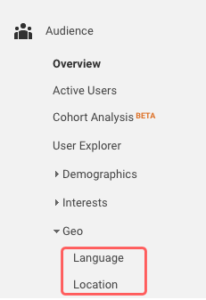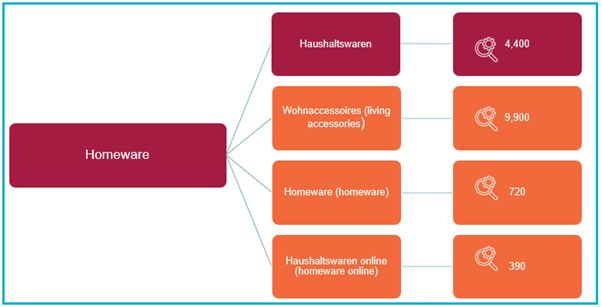
![]() Insights
Insights
International SEO strategy is the process of instructing Google (and other search engines) that you are targeting specific countries, and the languages you use in your business. Strategies outline the approach to optimising your website, improving organic visibility and performance across global markets, enabling search engines to identify the regions you wish to target.
This stretches across everything from handling your URL structure and domain name, to delivering consistent content relatable to your target language and culture. Whether it’s Google, Bing, Baidu, Yandex and another search engine, improving your ability to localise your international content reaps visibility benefits.
Recognising traffic from a number of regions may have led to thoughts around international expansion. The global market is extremely competitive. Optimising international SEO is a great way to boost traffic and promote customer-centric values. Achieving high SERP rankings for relevant keywords in multiple languages requires a deep understanding of linguistics and in-country search behaviour.
Authenticity is crucial to the success of multilingual campaigns. A well translated and localised website connects to your audience with a personal and relatable depth. Building loyalty, encouraging return customers, and increasing ROI.
Finding out how your website ranks in your targeted countries is a key indicator to your international SEO potential.
Compare your rankings with local businesses. Your obvious competitors may not be the most successful in terms of their digital presence.
Using Google Analytics’ language and location features in Audience > Geo, you’re able to view the number of users from particular regions.

Alongside market and audience research, SEO signals can help decide where and when is best to expand your business, including:
SEO signals highlight gaps in the market or demands for your product / service. Once you have located the market(s) you want to target, it’s time to plan your strategy. Every region carries individual behaviours and nuances, making it vital to outline a bespoke approach when entering a new market.
After identifying the market you wish to conduct business in, it’s time to truly understand that market. Researching, analysing and planning your campaign is key to implementing a successful international SEO strategy.
Spending time getting to know your audience and market will encourage a localised presence, build an effective SEO strategy and avoid launching into a market without much demand for your business.
Replicating English speaking strategies in global markets does not carry the same relevance as a true understanding of local language, people and culture.
Understanding and relating to the audience you are working with is paramount.
Breaking down your strategy into sections is a great way to gain an overview and tweak according to your audience. We have broken down the international SEO strategy into three sections: technical, content and cultural.
Adapting your website for multiple languages is essential to transitioning to an international market. Various options come with pros and cons, dependent on your strategy and business goals.
The three main structure options (using a French website as our example) consist of:
1. ccTLD (country code top-level domain) – e.g. example.fr
2. Sub-folder – e.g. searchlaboratory.com/fr
3. Sub-domain – e.g. fr.searchlaboratory.com
The key decision-influencing factors were identified as:
1. Authority
2. Trust
3. Cost
4. Geo-targeting
5. Short-term impact
6. Long-term impact
Here is an outline of the pros and cons to each option, and how they may be best suited to your business.
| ccTLD | Sub-folder | Sub-domain | |
| Authority |
Low The domain authority for each site would be self-contained and not shared across the sites. |
High
Each sub-folder would benefit from the link authority possessed by the top-level domain, especially if internal linking was used efficiently. |
Low
The site will struggle to benefit from authority held by the main site. |
| Trust | High
A native user in each market is likely to place the highest degree of trust in a ccTLD that is specific to their country or region. |
Medium
The localised sub-folder would be looked upon favourably, but native users may place less trust in this compared to a ccTLD. |
Medium
As with a sub-folder, the localised sub-domain would be looked upon favourably, but native users may place less trust in this compared to a ccTLD. |
| Cost | Medium
The additional cost of buying, setting up and maintaining each domain could be costly, depending on the size of the website. |
High
There would be low costs to set up each individual sub-folder and maintain them through the parent domain. |
High
There would be low costs to set up each individual sub-domain and maintain them all through the parent domain. |
| Geo-targeting | High
A ccTLD is a strong location signal to Google, which increases ranking potential. It can be geo-targeted in Google Search Console. |
Medium
The region-specific sub-folder would be viewed favourably by Google, but only if hosted on a generic top-level domain such as .com or .org. It can also be geo-targeted in Search Console. |
Medium
The region-specific sub-domain would be viewed favourably by Google, but only if it was hosted on a generic top-level domain such as .com or .org. Again, it can be geo-targeted in Search Console. |
| Short-term impact | Low
It would take a while to build link authority for a brand new domain and therefore the site may not rank as quickly as a sub-folder |
Medium
More immediate authority would be passed through to the site, due to it being hosted on the top-level domain which already holds inbound link authority. |
Low
It would take a while to build link authority for a brand new sub-domain and therefore the site may take longer to rank than a sub-folder. |
| Long-term impact | High
An authoritative domain on a unique ccTLD would have strong long-term ranking potential and be conducive to improved performance |
High
A localised sub-folder on a generic domain has the potential to hold a lot of link authority, ranking potential and be appealing to native users. |
Medium
An authoritative sub-domain on a generic TLD would have strong ranking potential but may be slower to rank. |
Google advise there is no one strategy superior to another. Understanding how URL structures work is key to deciding what is going to work best for you.
Using a ccTLD URL structure would mean creating a separate, country-specific site for your market, eg:www.example.fr
This option benefits from clear instructions to Google that each site is for a country-specific audience and content is explicitly divided making it easier to target users from this region.
However, if you are wanting to target 20 countries, you will need 20 websites. This can be time consuming and expensive, plus if you are yet to build brand authority, building a website from scratch in a new market will struggle to rank.
Sub-folders keep everything under the umbrella of your main site, eg: www.searchlaboratory.com/fr.
Managing cross-country content with this method saves time and money. If you know content will only vary slightly across your different markets, an umbrella site keeps everything central, whilst maintaining the strength of your domain authority.
Although, there is potential for users to struggle to navigate country-specific offers and content. Automatic redirection is bad for international SEO, risking sending visitors to incorrect country-specific pages and damaging user experience.
Using sub-domains also calls for creating new sites, eg: fr.searchlaboratory.com.
This option allows you to keep content and offers divided via country similarly to ccTLDs. You are also able to keep the top-level ‘.com’ portion of your URL which is important for some businesses. Maintenance across multiple sites is required with sub-domains, as well as having to build domain authority from zero. Some users may struggle to understand from the URL whether they’re in the right place.
Read more about the user experience benefits of localising URLs for new language sites here.
Immersing your site into the language and culture of international regions nurtures a more positive and relatable experience for users. Pushing consistent, localised content enables you to consider cultural differences, attracting international visitors and encouraging traffic from specific locations.
SEO signals are a great tool to direct search engines towards specific regions your site is targeting, embedding content into the culture with the likes of:
The location of your server heavily influences how your website ranks in search engines. Site speed also reflects the distance of the server, which dictates user experience, and can very easily be the difference between converting, and losing a customer.
Building a strong brand is vital for entering new markets. Creating authority around your localised website enables the opportunity to compete with local competitors. However, there is no one-size-fits-all approach to campaigns in global markets.
There are multiple key differences in the types of content that get covered internationally, meaning it is often best to create market-specific campaigns before localising and going live.
Learn more about what content works in different regions in this comprehensive guide analysing two years of data across multiple markets.
Building links to local content is often overlooked in international SEO strategies. Local blogs and media publications will often link to a brand’s parent site if there is no localised version for their market, and we can contact these sites asking them to redirect any links to the relevant domain once it has been set up.
While this link strategy does involve removing quality links from the parent site profile, redirecting links to the relevant site allows a better experience for both search engines and users.
Check out these five quick win tactics to build links in new international markets.
Identifying with local keywords in your targeted region often means going beyond Google. Despite the search engine’s dominance over most markets, this is not universal.
Check out the below leading search engines:
Deciding on which search engines to optimise is key to your international SEO strategy. Market shares vary across the web, dependent on the device, location and needs of the audience.
For example, Bing has a strong presence in the console market, covering 36.96% of US console searchers. If your target audience favoured console users, optimising your website for Bing is a strong rival against Google. Similarly in the Chinese and Russian markets, Baidu covers 82.47% of China’s search engine market, and Yandex holds 60.07% in Russia.
Researching into how different search engines benefit your campaign is crucial to both engagement and budget management. Google has a market share of 95.45% in India, making it difficult to optimise anywhere else if you are targeting this region.
After you have built a library of your audience behaviours, decided on your technical approach and studied the nuances of your market, it’s time to use this data to inform your content strategy.
Once you have an understanding of the keywords ranking highly for competitors, you can deepen this insight with multiregional research. Explore local regions to determine whether they have their own set of keywords, which keywords overlap and which rank well in one place and not so well in another.
Keyword research maximises visibility and relevance for your website. Revealing what is attracting traffic to the current market, keyword data enables you to build ranking terminology into your content, improving your chances of being visible in international search engines.
However, customers in different countries do not use the same terminology when performing a search for the same products or services. Straight translation often misses key terms that users in another country would use to search.
Tracking your keywords in multiple locations will allow you to identify keywords that carry the most potential for generating leads. This research also builds on your understanding of your target region and helps remain relevant amongst local trends.
For example, directly translating the term ‘homeware’ for a German market under ‘haushaltswaren’ would identify 4,400 monthly searches to target. However, by skipping local market keyword research, the translation misses three alternative search terms, and therefore 11,010 monthly searches and potential conversions.

Learn more about why local keyword research matters in this guide.
Once you have conducted local keyword research, the next step is to run this against local competitors. Pushing your data into a rank tracking tool will reveal a list of domains ranking for the keywords entered in your target area. You can also feed each keyword individually into Google and note which sites are ranking highly.
From this data, we are able to verify:
Now we have a greater insight into what is working within our chosen market and can use this data to help inform our strategy.
Your keyword research may reveal some keywords from your list that competitors are not ranking for. This is a strong place to start for creating new content.
Explore several competitors and SERP results to gather further keywords to enrich your content. Identify the terms which are bringing a high search volume and use this to inform your strategy, alongside your core keyword research.
Implement the target keywords into your content using the data from your research. From product descriptions, images, names and pricing, reflecting your new market’s demands will localise your presence and boost your site’s visibility.
Alongside changes to copy and keywords, the layout and user experience of your site should reflect the cultural differences in your new market. Aim to reflect the realities of your audience. Every country responds differently to images, copy, colour, layout, and everything in-between.
Avoid direct translations in your content. Allow your keyword research to inform your strategy, whilst thinking beyond words to align with your audience’s identity. Fonts, messaging, and imagery are all highly receptive to different regions and considering your market’s nuances will put you ahead of competition.
Removing any barriers for local users encourages conversion through simplified, easy to navigate structures. Inside retail markets, payment options, customer service and logistics all carry the potential to convert users, whilst promoting positive word of mouth and customer retention.
Aim to answer your audience’s questions with your content, producing valuable insights and hosting simple and efficient form fills for B2B markets. Ease of access to the relevant information your targeted decision-makers are looking for is key to generating leads and ultimately driving revenue.
If you manage SEO campaigns in multiple international markets, our free Chrome extension which we built in-house allows you to easily see what localised SERPs would look like in the country and language you intend it to be seen in.
Google always displays the most locally relevant search results for your location, no matter what ccTLD is used, which makes it hard for international digital marketers to check their position in the local SERPs. Our plugin allows you to select the language and location you want to check, without having to manually search for the language and regional codes and construct the URLs in the correct format, you can check it out here.
For further information on how we can help you with your international SEO strategy, please get in touch.

![]() Insights
Insights

![]() Insights
Insights

![]() Insights
Insights